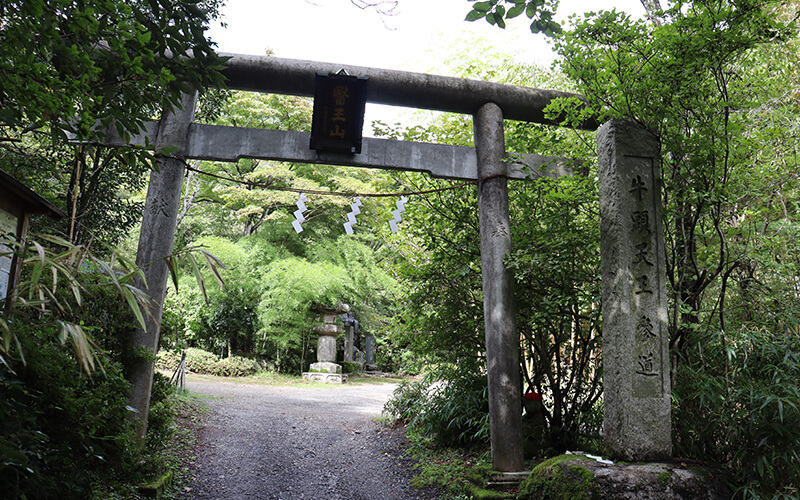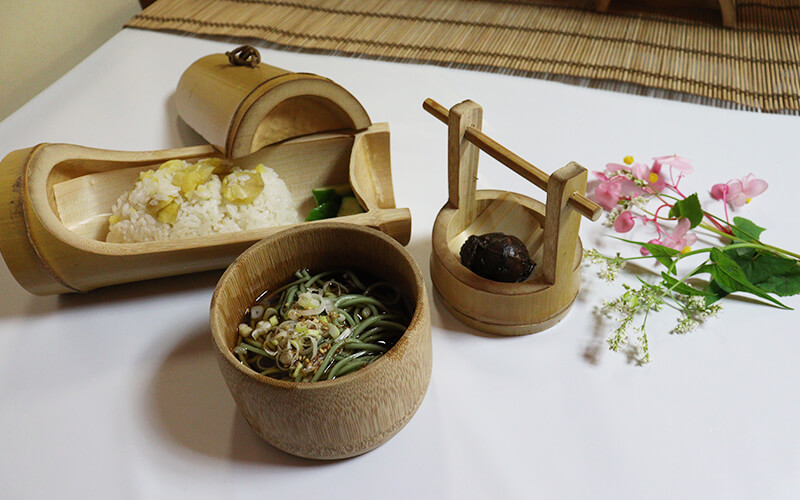Experience an extraordinary wellness in Saitama. ーEnjoy unique Japanese experiences in a relaxing space of tranquility!ー
features

Updated on:2024.10.23

This time, we’d like to introduce a journey where you can experience Japan’s unique culture in the outskirts of Tokyo and feel wellness that relaxes both your mind and body.
Located just north of Tokyo, it is in an area blessed with abundant greenery in Saitama. While Kyoto, Nara, and Kamakura are well-known as tourist destinations in Japan where you can enjoy temple visits and walks through bamboo groves, there is actually a place in the outskirts of Tokyo where you can not only enjoy these but also have special experiences unique to Japan.
This time, we will introduce experiences at temples nestled in bamboo groves, Shojin cuisine (Buddhist vegetarian cuisine), and programs where you can learn about Japanese tea.

◆ Temple of Scenic Beauty and Healing, Takedera Temple
Located in the mountains at an elevation of around 490 meters in Hanno City, within the region known as “Okumusashi” in the southwestern part of Saitama Prefecture, Takedera is a temple with a history spanning over a thousand years. In Japanese, “ta-ke” means bamboo, and this temple certainly lives up to its name. Within its grounds lies a stunning bamboo grove, enveloping the entire area surrounding the temple.
Standing quietly in the mountains and surrounded by a bamboo forest, the temple is affectionately referred to by locals as the “bamboo temple.” It enshrines the deity known as Gozu Tenno, revered as a guardian against epidemics or contagious diseases.


◆Experience the Healing Sound of “Shakuhachi”
By participating in a tour here, you can enjoy a special experience of playing the shakuhachi, a bamboo flute that has been passed down in Japan since ancient times as an instrument for Buddhist rituals and practices. The shakuhachi gained popularity as music for religious ceremonies associated with Buddhism and gradually evolved into an art form.
The shakuhachi is a type of vertical bamboo flute made from Madake bamboo that grows in Japan. Its name is derived from its traditional length, which was 1 shaku and 8 sun (approximately 55cm) according to ancient Japanese measurement units.
Even beginners will have the opportunity to learn how to play the shakuhachi from a teacher who is a professional shakuhachi player.
The flute, which many of you may be familiar with, is a musical instrument very similar to the shakuhachi. The principle of producing sound by blowing air over a notch (or edge) on the tube is the same for both instruments. However, while the flute is a transverse flute, held horizontally, the shakuhachi is a vertical flute, held vertically (in front of the player).


The technique of playing the shakuhachi is to place the lips directly onto the slanted top edge of the instrument called the “utaguchi,” while using fingers to cover the five holes on the front and back of the flute. This technique produces a warm, glossy, and somewhat breathy sound.
This sound has been described as “Ichion-Jobutsu,” which means achieving enlightenment with a single sound. It signifies putting one’s soul into each note, facing one’s own spirituality through the act of creating music. From this perspective resembling Buddhist practices, the shakuhachi is more than just a musical instrument. It has played a role as a ritual implement, possessing a significance not found in Western instruments or other traditional Japanese musical instruments.
The unique sound of the shakuhachi is said to express something that cannot be conveyed by any other instrument.
In this experience tour, the instructor will teach the proper posture, breathing, and techniques for playing the shakuhachi.
Initially, it might take some time to produce sound, but the instructor emphasizes that unifying one’s mind is crucial when engaging with the shakuhachi.
◆Playing the Shakuhachi in the Bamboo Grove for Relaxation
Yes, this is Takedera (Bamboo Temple). The whole area is surrounded by a stunning bamboo forest. After receiving lessons on the tatami mats about playing the shakuhachi, it’s time to head out to the bamboo grove with the Shakuhachi in hand.
Among the tranquil silence surrounded by bamboo, concentrating on playing the shakuhachi, you’ll likely feel a sense of relaxation both mentally and physically. Additionally, wearing fukaamigasa hat (an open weave basket-like hat that cover the whole head) helps to enhance concentration by blocking out visual distractions.
The shakuhachi, born in Japan in the 13th century, has persisted while holding onto its unique tone. By taking a step away from the stress of modern society and immersing oneself in the healing elements of nature, the sound of the shakuhachi brings about a relaxing effect and helps maintain a healthy state of mind and body.
It will surely make you feel calm.
For those who are interested in experiencing the shakuhachi for the first time or for those wanting to enjoy an experience at a temple surrounded by Japan’s unique nature and environment, we encourage you to visit.
For more details about the tour, please click here.
https://www.tripadvisor.com/AttractionProductReview-g298176-d21229913-Wellness_in_Saitama_Takedera_Blowing_Zen_Meditation_Hot_Spring-Hanno_Saitama_Prefe.html


◆Enjoy Buddhist vegetarian cuisine at Takedera
At the Bamboo Temple, you can savor Shojin cuisine, a form of Buddhist vegetarian cuisine featuring seasonal mountain vegetables and more. As advance reservations are required, we recommend requesting this option when booking the tour.
Meals at the Bamboo Temple are served in a traditional wooden building with tatami flooring, adorned with accents of bamboo throughout. Inside the building, some parts of the floor are removed to allow bamboo to grow within the rooms.
While waiting for your meal, take a moment to explore the interior of the room. At the end of the hallway, sliding doors reveal a picturesque view of the bamboo forest. Sitting on chairs, you can relax and momentarily forget the everyday world.
The meals offered at temples consist of Shojin cuisine, featuring seasonal vegetables, leafy greens, and bamboo shoots generously. The beautifully arranged bamboo dishes will satisfy both your eyes and your appetite.
The menu changes according to the visiting season, offering dishes such as soba or udon noodles, along with vegetable and bamboo shoot mixed rice.
For more details about “Takedera,” please visit:
https://takedera.net


◆ Let’s learn about “Sayama Tea,” one of Japan’s three renowned teas
If you visit this area, there’s another experience we highly recommend. For those visiting Japan, you might be interested in learning more about tea.
It is said that Japanese tea has a history spanning over 1200 years. Even with the same variety, characteristics differ depending on its production area.
Sayama Tea, cultivated around the Sayama Hills in Saitama Prefecture, is recognized as one of Japan’s three renowned teas. The surrounding areas of Iruma City, visited this time, are dotted with tea fields. Sayama Tea originated from tea plants grown in Kawagoe and is said to have flourished during the mid-Edo period (1603–1868) in Saitama Prefecture.


Tea plants naturally thrive in warm climates, making them susceptible to cold temperatures. For this reason, efforts have been made over the years to cultivate tea trees that are more resilient to cold and to utilize leaves grown in colder regions, prioritizing taste over the shape of the tea. This approach to tea production, emphasizing taste rather than the tea’s appearance, has been practiced in the Sayama tea production area.
As this area has a cool climate for tea production, the tea plants store more nutrients internally during the winter, creating tea with a good balance of umami and bitterness.
Additionally, the drastic temperature changes appear to be a secret to the deliciousness of Sayama Tea. As a result, the tea leaves are thick and have a rich flavor.
Due to the limited number of times tea can be harvested in this cool climate, the production of tea in Saitama Prefecture, where Sayama Tea is cultivated, only makes up about 2% of Japan’s total tea production. This makes it highly valuable and rare.
Sayama tea has distinctive characteristics due to the “Sayama Biire” process that is done during the finishing stage, imparting a unique aroma, and utilizing thick leaves grown under stringent climatic conditions, resulting in a sweet, rich, and flavorful taste.

To delve into the various types of Sayama tea and learn how to brew it deliciously, there’s the “Sayama Green Tea School.” Not only can you learn about tea leaves, but you can also understand factors such as water temperature, brewing techniques, and how brewing time affects the taste. You’ll have the opportunity to taste and compare these flavor differences firsthand. The Sayama Green Tea School offers various courses for learning about tea, including English explanations and assistance.
For further details about the “Sayama Green Tea School,” please visit:
https://en.sayamagreenteaschool.com


◆How about immersing yourself in the middle of expansive tea fields?
For those who love tea, there’s another recommended spot in Iruma City where you can have a special experience.
In the heart of extensive tea fields, you’ll find a tea field terrace named “Chanowa” that Offers a 360-degree panoramic view of the tea plantations.
While relishing the feeling of openness, you can enjoy sipping tea, admiring the tea fields and the wide sky, capturing memorable photos, tasting various teas, treating yourself to a special, rich green tea (Sencha) gelato made by local tea shops, or even taking a nap. There are several plans available, and reservations in advance are recommended.
For more details about Japanese tea field terrace “Chanowa,” click here.
https://saitama-supportdesk.com/experiences/immerse-yourself-in-nature-with-our-japanese-tea-terrace-chanowa-private-party-plan/

What do you think about this wellness journey in Saitama, right next to Tokyo, where you can fully indulge yourself?
This time, we introduced various special experiences that allow you to relax both mentally and physically.
Why not join a tour with your friends or family?
Surely, these experiences will become cherished memories in Japan and make you want to come back again!











